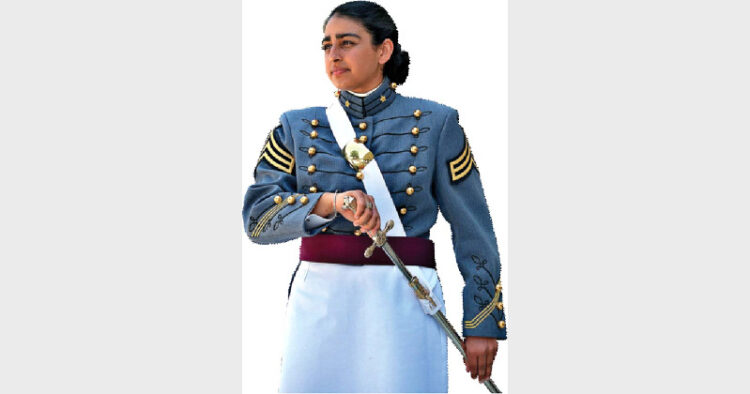Anmol had a fascination for military service from her childhood. Her maternal grandfather had served in the Indian Army. She grew up hearing about tanks and his recollection of fighting in the mountains of northern India. All this developed her interest in the military
-Nilima Pathak

Anmol Kaur Narang is a second-generation immigrant (Photo Credit – 2LT Lauren E. Karbler)
A second-generation immigrant, Anmol Kaur Narang, has created history by becoming the first ‘observant’ Sikh to graduate from the United States Military Academy at West Point, New York, recently.
The second lieutenant, gushed, “It’s an amazing feeling. I worked hard for it. As a result, irrespective of the career field, if my experience has inspired others, I feel blessed. Being a Sikh woman is an important part of my identity and I am proud of it.”
With the exception of the Army and the Air Force, the military largely prohibits its members from serving with turbans, unshorn hair and unshorn beard; all considered articles of faith for Sikhs. As per the Army standard for women’s hair, the bun must be no larger than 3.5 inches in diameter. Born and raised in Roswell, Georgia in the United States, Anmol’s, hair hangs to her knees. But she did not seek any religious accommodation. Instead, the perky girl practiced pinning a bun tight enough to meet the requirement. She succeeded and is proud of her tresses.
Fight for right
The Sikh Coalition, a Sikh-American group that defends Sikh civil rights, informed that in 1987, the US Congress had passed a law that prohibited Sikhs and several other religious communities from maintaining their articles of faith while serving in the military.
Along with other Sikh and civil rights organizations, litigation partners and like-minded advocates, the Sikh Coalition led a decade-long campaign to ensure equality of opportunity for Sikh Americans in the US Armed Forces.
In 2017, the Army updated its rules governing religious liberties and the ban was lifted. Anmol’s graduation marked an incredible success for Sikh Americans, thus, breaking a barrier of a 218-year-old military academy.
What is West Point?
It is the oldest continuously occupied military post in the United States. Located on the Hudson River in New York, West Point was identified by General George Washington as the most important strategic position in America during the American Revolution.
Until January 1778, West Point was not occupied by the military. On January 27, 1778, Brigadier General Samuel Holden Parsons and his brigade crossed the ice on the Hudson River and climbed the plain on West Point. Ever since the US Army has occupied the area comprising approximately 16,000 acres, including the campus of the United States Military Academy, which is now referred to as West Point.
Earning her stripes
Anmol had a fascination for military service from her childhood. “My maternal grandfather had served in the Indian Army. I grew up hearing about tanks and his recollection of fighting in the mountains of northern India. All this developed my interest in the military and imbibed the culture of service and giving back to my country,” she explained.
She was delighted on comprehending that she could pursue her education along with training at the Academy. She recalled, “During my junior year in high school, along with my parents, I visited the Pearl Harbor National Memorial in Honolulu, Hawai’i. Sensing the sacrifice of those people and the impact it had made firmed my resolve to join the armed forces.”
On returning to the hotel room, she began the process of applying for the West Point. “I attended one year of undergraduate study at the Georgia Institute of Technology. Transfer to West Point followed. I then studied nuclear engineering to pursue a career path in air defence systems, earning my stripes and degree with dedication,” she informed.
President Trump addresses Indian-American Army officers
It is the oldest continuously occupied military post in the United States. Located on the Hudson River in New York, West Point was identified by General George Washington as the most important strategic position in America during the American Revolution.
Until January 1778, West Point was not occupied by the military. On January 27, 1778, Brigadier General Samuel Holden Parsons and his brigade crossed the ice on the Hudson River and climbed the plain on West Point. Ever since the US Army has occupied the area comprising approximately 16,000 acres, including the campus of the United States Military Academy, which is now referred to as West Point.
Perseverance pays
As the only Sikh cadet in the batch, Anmol was confronted with a challenge that her grandfather perhaps never had to face. With no other Sikh American to turn to, it was hard on her, especially in regard to her religion.
“Displaced from my family, relatives and friends who practiced Sikhism was a reality that I was not accustomed to. I was used to attending prayers every Sunday at a gurudwara. So, suddenly forming my own one-person community was a bit disturbing in the beginning. But, the support of my parents and family, who often sent letters and communicated with me, helped me through that phase,” she said.
Ever since the Army and the Air Force changed their policies, about 60 observant Sikhs have been serving in the two branches. The United States is ensuring equality of opportunity for Sikhs in the Navy, Marine Corps and Coast Guard
Anmol carved out her own prayer routine. To release the stress that was also a result of the physical training, she relied on devotion towards her religious values. Her dedication and perseverance soon showed in her bright results and became a lesson for those wanting to reach their goal and rise to the challenges.
What does the future hold?
Following the Basic Officer Leadership Course (BOLC), Anmol will head to her first posting at the Kadena Air Base in Okinawa, Japan in January 2021. Expected to work closely with the Air Force, she looks forward to serving as an air defence artillery officer.














Comments